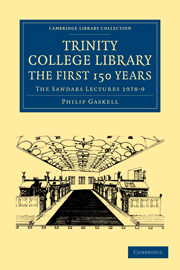Book contents
- Frontmatter
- Contents
- Lists of illustrations and plans
- Preface
- Terms and conventions
- Abbreviations
- 1546–1600
- 1601–1695
- 9 The New Library
- 10 Stanhope's Librarianship
- 11 Collections of manuscripts
- 12 The growth of the working collections, 1601–40
- 13 The arrangement of the books, 1601–40
- 14 Administration and reorganisation, 1641–74
- 15 The book stock, 1667–95
- 16 The last years of the New Library
- APPENDIXES
- Index
16 - The last years of the New Library
Published online by Cambridge University Press: 05 August 2011
- Frontmatter
- Contents
- Lists of illustrations and plans
- Preface
- Terms and conventions
- Abbreviations
- 1546–1600
- 1601–1695
- 9 The New Library
- 10 Stanhope's Librarianship
- 11 Collections of manuscripts
- 12 The growth of the working collections, 1601–40
- 13 The arrangement of the books, 1601–40
- 14 Administration and reorganisation, 1641–74
- 15 The book stock, 1667–95
- 16 The last years of the New Library
- APPENDIXES
- Index
Summary
Thomas Griffith died in his late fifties in March 1674, and was succeeded as Librarian by James Manfeild, a Scholar and MA of the College then aged about twenty-six. Five years later, in 1679, Manfeild exchanged the Librarianship for a College Chaplaincy held by John Laughton; then in 1684 he was elected University Librarian; and he remained both College Chaplain and University Librarian until his death in 1686. In about 1675, when he was Librarian of Trinity, Manfeild made an efficient new class catalogue of the printed books (1675) (fig. 28). This was a considerable improvement on Griffith's catalogue of 1667, for it included more accurate headings, the individual cataloguing of multi-item volumes, and the addition of places and dates of publication. It was also during Manfeild's Librarianship that the College decided to build the Wren Library, a matter to which we shall return.
John Laughton, Manfeild's successor as College Librarian, was a Scholar and MA of the College who had been appointed College Chaplain in 1678 and who then gave up his Chaplaincy in favour of the Librarianship in 1679, when he was aged thirty. Four years after that he exchanged offices with Thomas Rotherham, another of the Chaplains, Rotherham becoming Librarian and Laughton taking Rotherham's Chaplaincy. Finally Laughton was elected University Librarian in 1686 in succession to Manfeild, holding both the Chaplaincy and the University Librarianship until his death in 1712.
- Type
- Chapter
- Information
- Trinity College Library. The First 150 YearsThe Sandars Lectures 1978–9, pp. 134 - 144Publisher: Cambridge University PressPrint publication year: 2010First published in: 1980



